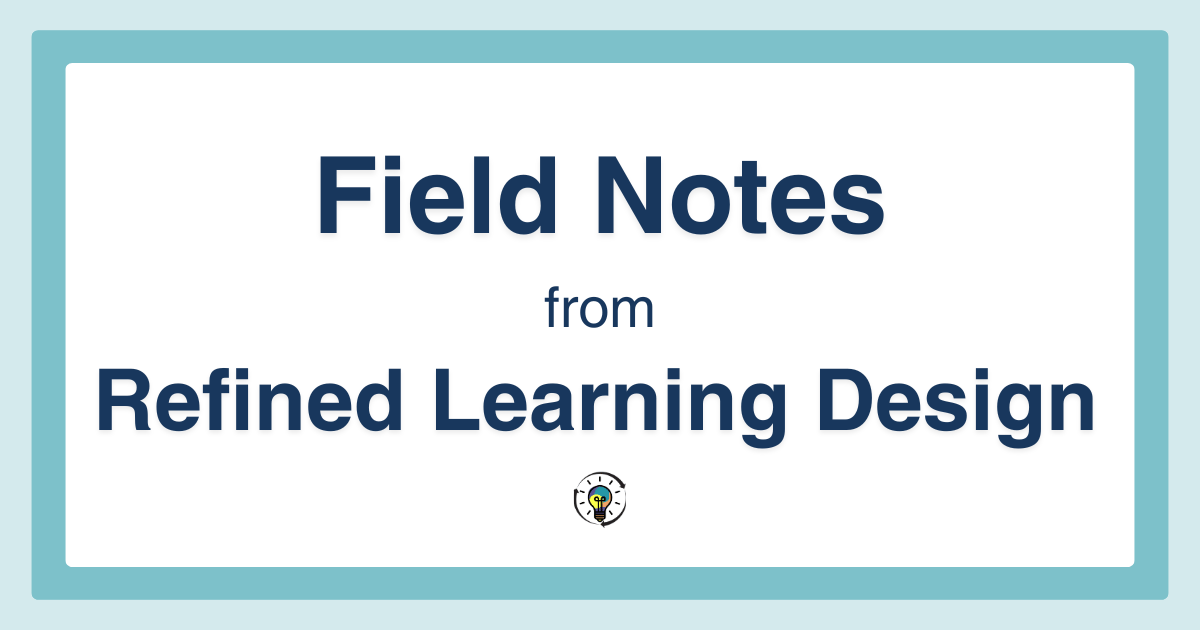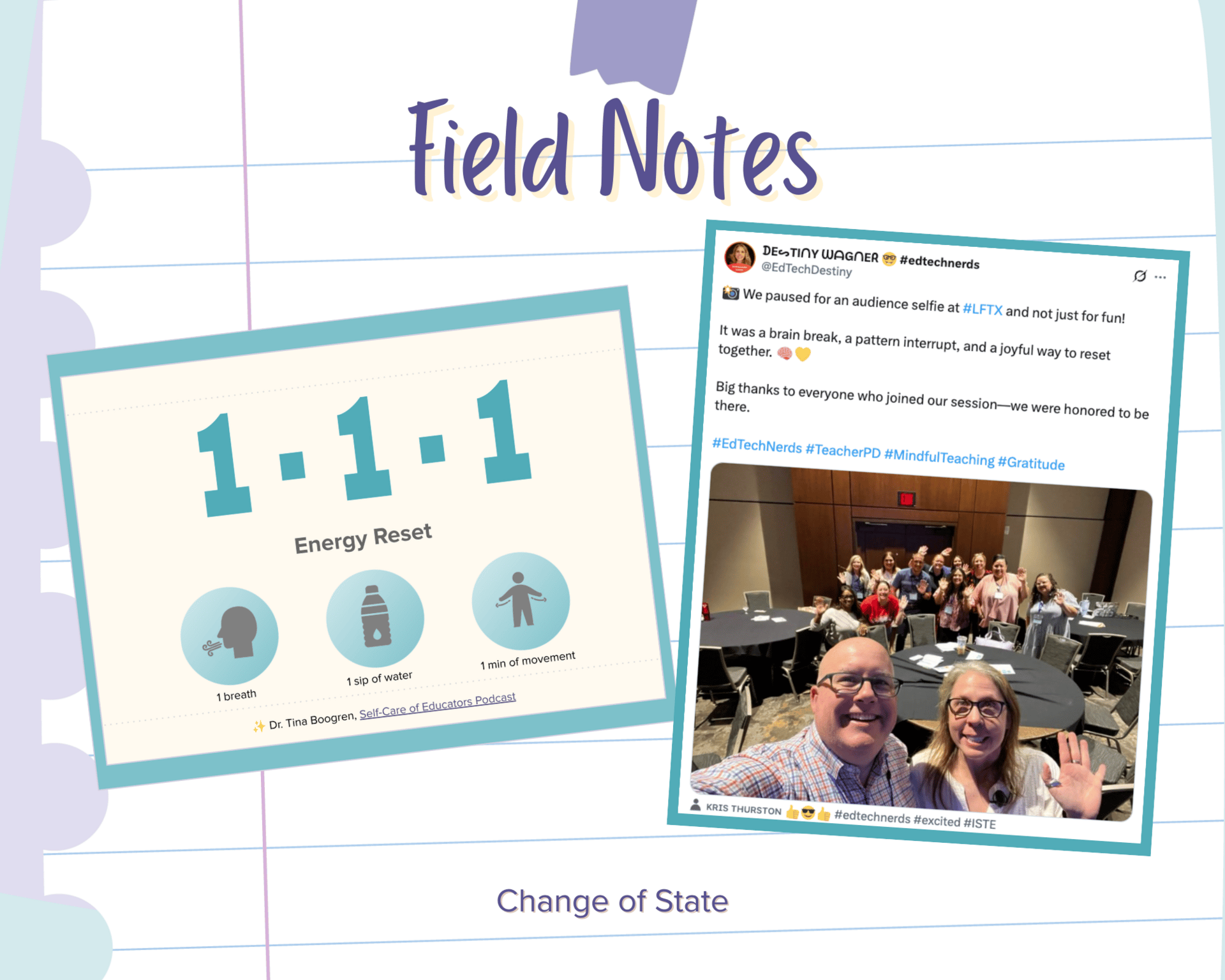- Field Notes: Refined Learning Design
- Posts
- Change the State, Change the Learning
Change the State, Change the Learning
A Pause with Purpose: Intentional design choices to reset energy and attention

Hi there,
Welcome to the second issue of Field Notes from Refined Learning Design. Whether you’re back from last month or joining in for the first time, I’m glad you’re here. If you missed the first issue, you can read it here.
Each month, I share one idea I’ve been exploring—something that’s sparked reflection or shaped how I design professional learning lately. You’ll also find at least one resource recommendation, a quote I can’t stop thinking about, and a peek into what’s happening in my community of PL designers.
This month’s field note reflects on the benefits of “interruptions.”
📓 Field Note: Change of State
📍 In sessions I attended and facilitated
💡 Thoughtful interruptions can elevate the learning

photos of the 1-1-1 Slide and the EdTech Nerds session selfie
From Settling In to Switching Gears
The idea of a brain break is pretty ubiquitous in classrooms and PD sessions. But really, why is that so important? We know our bodies need to move and stretch, and after long days of listening and learning, our brains are full and tired, so these breaks are important for both adult and student learners. (Were full days of back-to-school PD good reminders of how much we need those breaks?)
At a conference in 2023, I was in a presentation facilitated by The EdTech Nerds, who taught me the term pattern interrupt. They shared research on the importance of this type of brain break, and their classic move is to stop and take a group photo, which allows the audience to move to the center of the room and then reset for the rest of the session.
Pattern Interrupt: a quick, unexpected shift that snaps people out of autopilot and signals, “Something new is starting.”
Recently, I had a small role in Learning Forward Texas’ new Tips and Tools 2 presentation. The main presenters, the fabulous Terri and Elita, modeled the power of changing the states as the learning progressed throughout the day. With two presenters, participants experienced different personalities, voices, and energy levels. The facilitators wove in a variety of modalities of learning throughout the day, and paired each with thoughtful music choices that supported the content.
State changes are any intentional shifts in energy, activity, or environment that resets attention and engagement.
When it was my turn, my vibe, tone, and learning activities were completely different, so I opened with, “Get ready for another state change!” These intentional shifts, whether it’s a change in presenter, activity, or energy, are like a reset button for both brain and body, helping participants refocus and re-energize for what’s next.
I’ve always been the kind of learner who likes to settle in and stay put for the day. But I’m learning how powerful these deliberate breaks, moments of movement, and changes of state can be for our attention, engagement, and memory.
Insights from Engagement Experts
At the recent Tips and Tools 2 session, Terri and Elita reminded us the importance of state management with Eric Jensen’s insight:
“If people are not in the state to learn, we must change the state.”
That’s exactly what intentional transitions and “pattern interrupts” do; they reset energy, attention, and focus.
Authors Chip Heath and Dan Heath (The Power of Moments) found that when we remember an experience, we tend to recall the peaks and the endings. Every time we pause and start again, we create another chance for both.
Richard Thaler and Cass Sunstein (Nudge) use the term choice architecture to describe how small, intentional design decisions can influence people’s behavior. In facilitation, a change of state is choice architecture for engagement. It’s a deliberate design move that shifts the environment, activity, or energy to help learners choose to re-engage and refocus.
💡 Facilitation Move: Change the State
Use beginnings, endings, and state changes as architectural features in your learning design, shaping how people focus and participate. Here are a few ways I’ve both experienced and used these intentional “interruptions” in sessions:
Pattern Interrupt (The EdTech Nerds) → “Stop. Move. Let’s take a session selfie!”
Change of State via Voice/Speakers → Switch presenters or share a short audio or video clip.
Change the Energy → Move to a different part of the room or rearrange seating; pair with music to set the mood.
Mini “Commercial Breaks” → A quick, lighthearted interlude (Tony Vincent’s dad jokes and kids’ commercials are always a hit).
"When you find yourself in a state that feels less than resourceful, use these two highly effective ways to create a change. Either change your physiology and begin moving in a more powerful and resourceful way, or change the focus of your attention."
I’m now always on the lookout for these types of changes of state, both as a participant and a facilitator, and noticing how they shift my energy, focus, and mood. Here’s one simple move you can try in your very next session.
Try This in Your Next Session
A new favorite, easy-to-implement idea comes from Dr. Tina Boogren and her Self-Care for Educators podcast: the 1–1–1 Energy Boost.
In my sessions, I set a timer for 90 seconds and invite participants to:
Take one big breath: inhale and exhale.
Take one sip of water.
Move for one minute (or whatever time remains).
Movement can be as simple as standing, stretching arms, marching in place, or rolling the shoulders and neck. For those who need more, I’ll suggest something playful, like walking over to touch the opposite wall.
This quick reset has been a hit all summer. I’ve used it in keynotes, short and long workshops, and even webinars. It’s simple, flexible, and (most importantly) it works, and would be easy to try in classrooms too.
🎧 I’ve embedded the podcast episode below if you’d like to hear Dr. Boogren describe it herself.
I’d Love to Hear
What’s your favorite way to reset the energy in a session? How do you help your participants refocus and re-engage? Or, which one of these strategies can you try this month?
Reply and let me know what works for you. Or share insights in your own space, and tag me so we can learn from each other.
Noting, reflecting, connecting,
Kathryn
PS: If something here sparked an idea, please forward this post to an EduFriend who’s also designing professional learning. ✨
Highlights from the Community
Here’s what’s happening in our community spaces this month:
The Mindful Musings prompts focus on reflections for back-to-school.
I’ve launched The Learning Shelf for monthly, community-driven book talks.
There are new posts in our Give and Receive space about our community members’ writing projects, a strategy for lasting learning, and more!
My first minicourse, Begin with Intention, is available for self-paced, asynchronous learning.
The Refined Design Learning Community is a space for curious, collaborative educators who design learning experiences for other adults. Our members are professional learning providers, educational coaches, PLC leads, admin, and aspiring PD leaders.
I use the Circle platform to host the community, and it’s free to join and participate. In our spaces, you’ll find thoughtful discussions, book clubs, and virtual meetups, which are open to all in the community. While I plan to offer paid courses in the future, nearly everything available now (except the one minicourse) is completely free.
We can be the designers of moments that deliver elevation and insight and pride and connection. These extraordinary minutes and hours and days—they are what make life meaningful. And they are ours to create.
Reflecting • Connecting • Refining
📓 Why Field Notes?
This newsletter is inspired by the idea of self-anthropology from Tiny Experiments by Anne-Laure Le Cunff. Just like field notes help researchers make sense of what they observe, these monthly reflections help me capture ideas, tools, and questions from my own work designing professional learning. I share them here in the spirit of experimentation, connection, and ongoing refinement.
🤖 AI helped polish this post, but the ideas, intention, curation, and care are all mine.

Reply